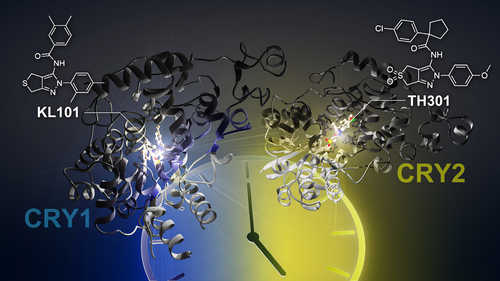The research team comprised of Designated Associate Professor Tsuyoshi Hirota and Postdoctoral Fellows Simon Miller and Yoshiki Aikawa, of the Nagoya University Institute of Transformative Bio-Molecules, has succeeded in the discovery of novel compounds to lengthen the period of the circadian clock, and has shed light on their mechanisms of action.
The circadian clock controls a variety of biological phenomena that occur during the course of the day, such as sleeping and waking. Perturbation of the circadian clock has been associated with many diseases such as sleep disorders, metabolic syndrome, and cancer. The development of small-molecule compounds to regulate specific components of the circadian clock facilitates the elucidation of the molecular basis of clock function, and provides a platform for the therapeutic treatment of clock-related diseases.
 New small molecules KL101 and TH301 target CRY1 and CRY2, respectively,
New small molecules KL101 and TH301 target CRY1 and CRY2, respectively,
to control the circadian clock. (Image by Issey Takahashi)
In this study, the research team discovered the small molecules, KL101 and TH301, that lengthen the period of the circadian clock. They found that KL101 and TH301 are the first compounds that selectively target clock components CRY1 and CRY2, respectively. By utilizing X-ray crystallography to determine the structures, they revealed how KL101 and TH301 bind to CRY1 and CRY2.
However, additional experiments were required to determine the mechanism of CRY1 and CRY2 selectivity. It was found that the disordered tail regions of CRY proteins impart compound selectivity. Additionally, in collaboration with Project Associate Professor Megumi Hatori and Postdoctoral Fellow You Lee Son of the Keio University School of Medicine, they found that CRY1 and CRY2 are required for the differentiation of brown adipocytes, and both KL101 and TH301 are expected to provide a promising foundation for the therapeutic treatment of obesity.
The article, "Isoform-selective regulation of mammalian cryptochromes," was published in the journal Nature Chemical Biology on March 30, 2020 at DOI: 10.1038/s41589-020-0505-1
This research was carried out in collaboration with the groups of Kenichiro Itami, Florence Tama and Ayato Sato of the Institute of Transformative Bio-Molecules, Steve Kay of the University of Southern California, Shinya Oishi of Kyoto University, Kunio Hirata of RIKEN, and Kazuhiro Abe of Nagoya University.
It was supported in part by the MEXT WPI program, AMED PRIME program, JST PRESTO programs, MEXT grants-in-aid, PDIS, BINDS, Takeda Science Foundation, Suzuken Memorial Foundation, Uehara Memorial Foundation, Sumitomo Foundation, Astellas Foundation for Research on Metabolic Disorders, and Cell Science Foundation.
Find out more about ITbM:

